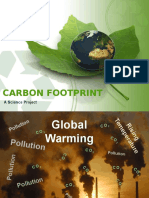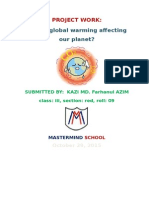Global Warming
Uploaded by
Abishek KumarGlobal Warming
Uploaded by
Abishek KumarWhat is Global Warming?
Global Warming is the increase of Earth's average surface temperature due to
effect of greenhouse gases, such as carbon dioxide emissions from burning
fossil fuels or from deforestation, which trap heat that would otherwise escape
from Earth. This is a type of greenhouse effect.
What are the Greenhouse Gases?
The most significant greenhouse gas is actually water vapor, not something
produced directly by humankind in significant amounts. However, even slight
increases in atmospheric levels of carbon dioxide (CO2) can cause a substantial
increase in temperature.
Why is this? There are two reasons: First, although the concentrations of these
gases are not nearly as large as that of oxygen and nitrogen (the main
constituents of the atmosphere), neither oxygen or nitrogen are greenhouse
gases. This is because neither has more than two atoms per molecule (i.e. their
molecular forms are O2 and N2, respectively), and so they lack the internal
vibrational modes that molecules with more than two atoms have. Both water
and CO2, for example, have these "internal vibrational modes", and these
vibrational modes can absorb and reradiate infrared radiation, which causes
the greenhouse effect.
Secondly, CO2 tends to remain in the atmosphere for a very long time (time
scales in the hundreds of years). Water vapor, on the other hand, can easily
condense or evaporate, depending on local conditions. Water vapor levels
therefore tend to adjust quickly to the prevailing conditions, such that the
energy flows from the Sun and re-radiation from the Earth achieve a balance.
CO2 tends to remain fairly constant and therefore behave as a controlling
factor, rather than a reacting factor. More CO2 means that the balance occurs
at higher temperatures and water vapor levels.
Global Warming Impacts
Many of the following "harbingers" and "fingerprints" are now well under
way:
1. Rising Seas--- inundation of fresh water marshlands (the everglades),
low-lying cities, and islands with seawater.
2. Changes in rainfall patterns --- droughts and fires in some areas,
flooding in other areas. See the section above on the recent droughts,
for example!
3. Increased likelihood of extreme events--- such as flooding, hurricanes,
etc.
4. Melting of the ice caps --- loss of habitat near the poles. Polar bears are
now thought to be greatly endangered by the shortening of their feeding
season due to dwindling ice packs.
5. Melting glaciers - significant melting of old glaciers is already observed.
6. Widespread vanishing of animal populations --- following widespread
habitat loss.
7. Spread of disease --- migration of diseases such as malaria to new, now
warmer, regions.
8. Bleaching of Coral Reefs due to warming seas and acidification due to
carbonic acid formation --- One third of coral reefs now appear to have
been severely damaged by warming seas.
1. effects from those warm temperatures that appear to have induced
recent worldwide drought).
2. Lastly, but perhaps most importantly, whether or not you believe in
global warming per se, the fact remains that the carbon dioxide levels
are rising dramatically --- there is no debate about this. If we continue
to use fossil fuels in the way we presently do, then the amount of carbon
we will release will soon exceed the amount of carbon in the living
biosphere. This is bound to have very serious, very negative effects,
some of which, such as lowering the pH of the ocean such that coral
cannot grow, are already well known.
Global Warming isincreasing the earth’s average temperature. The Green house
gases are the main culprits of the global warming. The green house gases like carbon
dioxide, methane, and nitrous oxide are playing hazards in the present times. These green
house gases trap heat in earth’s atmosphere and thus result in increasing the temperature
of earth. The excessive emission of these gases is the major cause of global warming.
The major source of carbon dioxide is the power plants. These power plants emit
large amounts of carbon dioxide produced from burning of fossil fuels for the purpose of
electricity generation. Coal is the major fuel that is burnt in these power plants. Coal
produces around 1.7 times as much carbon dioxide per unit of energy when flamed as
does natural gas and 1.25 times as much as oil. The coal gives out eighty percent more
carbon per unit of energy it produces as compared to natural gas. Another major source of
carbon dioxide in the atmosphere is the emission from the cars and other vehicles. About
twenty percent of carbon dioxide emitted in the atmosphere comes from burning of
gasoline in the engines of the vehicles. This is true for most of the developed countries.
Moreover if sports bike and vehicles that are essentially designed for rough terrain, emit
more carbon dioxide when used for general purpose on roads. It is always better to use
vehicles designed for city driving on the city roads.
Buildings, both commercial and residential represent a larger source of global
warming pollution than cars and trucks. Building of these structures require a lot of
fuel to be burnt which emits a large amount of carbon dioxide in the atmosphere.
The second major greenhouse gas after carbon dioxide, which causes global
warming, is Methane. Methane is more than 20 times as effectual as CO2 at entrapping
heat in the atmosphere. Methane is obtained from resources such as rice paddies, bovine
flatulence, bacteria in bogs and fossil fuel manufacture. Almost in all parts of the world,
rice is grown on flooded fields. When fields are flooded, anaerobic situation build up and
the organic matter in the soil decays, releasing methane to the atmosphere. Nitrous oxide,
which is a colorless gas with a sweet odour, is another green house gas. The main sources
of nitrous oxide include nylon and nitric acid production, cars with catalytic converters,
the use of fertilizers in agriculture and the burning of organic matter. Greater emissions
of nitrous oxides in the recent decades is leading global warming
Another major cause of global warming is deforestation. Deforestation is to be
blamed for 25% of all carbon dioxide release entering the atmosphere, by the
cutting and burning of about 34 million acres of trees each year. Trees collect the
CO2 that we breathe out and give away from various other sources, and they give back
oxygen that we breathe in. Thus, cutting of trees is leading to greater concentration of
carbon dioxide in the atmosphere. Greater urbanization, requirement of land for factories
and buildings, requirement of timber are all reasons that are leading to deforestation,
which in turn is leading to global warming.
What Can We Do?
We as individuals can do our part to reduce greenhouse gas emissions by making less-
polluting choices.
On the road:
• Purchase a fuel-efficient car or alternative fuel vehicle. Go to the MPCA's motor vehicle
pollution page for more ideas.
• Do all your errands in one trip rather than several.
• Keep your car tuned and your tires fully inflated.
• Consider alternative means of transportation, such as the bus, your bike or just walking.
• Telecommute to work.
In your home:
• Turn off lights, TVs and other electronic devices when not in use.
• Purchase energy efficient appliances that display the Energy Star label. Visit the Energy
Star Web site more additional information.
• Replace incandescent lights with energy efficient fluorescent bulbs or light fixtures.
6. Do not leave appliances on standby
Use the "on/off" function on the machine itself. A TV set that's switched on for 3 hours a
day (the average time Europeans spend watching TV) and in standby mode during the
remaining 21 hours uses about 40% of its energy in standby mode.
8. Move your fridge and freezer
Placing them next to the cooker or boiler consumes much more energy than if they were
standing on their own. For example, if you put them in a hot cellar room where the room
temperature is 30-35ºC, energy use is almost double and causes an extra 160kg of CO2
emissions for fridges per year and 320kg for freezers.
16. Use less hot water
It takes a lot of energy to heat water. You can use less hot water by installing a low flow
showerhead (350 pounds of carbon dioxide saved per year) and washing your clothes in
cold or warm water (500 pounds saved per year) instead of hot.
24. Reduce waste
Most products we buy cause greenhouse gas emissions in one or another way, e.g. during
production and distribution. By taking your lunch in a reusable lunch box instead of a
disposable one, you save the energy needed to produce new lunch boxes.
25. Plant a tree
A single tree will absorb one ton of carbon dioxide over its lifetime. Shade provided by
trees can also reduce your air conditioning bill by 10 to 15%. The Arbor Day Foundation
has information on planting and provides trees you can plant with membership.
26. Switch to green power
In many areas, you can switch to energy generated by clean, renewable sources such as
wind and solar. In some of these, you can even get refunds by government if you choose
to switch to a clean energy producer, and you can also earn money by selling the energy
you produce and don't use for yourself.
32. Reduce the number of miles you drive by walking, biking, carpooling or taking
mass transit wherever possible
Avoiding just 10 miles of driving every week would eliminate about 500 pounds of
carbon dioxide emissions a year! Look for transit options in your area.
First, it will raise sea levels. There are 5,773,000 cubic miles of water in ice caps,
glaciers, and permanent snow.
Second, melting ice caps will throw the global ecosystem out of balance. The ice caps
are fresh water, and when they melt they will desalinate the ocean
Third, temperature rises and changing landscapes in the artic circle will endanger several
species of animals. Only the most adaptable will survive.
Fourth, global warming could snowball with the ice caps gone. Ice caps are white, and
reflect sunlight, much of which is relected back into space, further cooling Earth. If the
ice caps melt, the only reflector is the ocean. Darker colors absorb sunlight, further
warming the Earth.
You might also like
- Mitigating Co From Atmosphere Greenearthers Team Members: andNo ratings yetMitigating Co From Atmosphere Greenearthers Team Members: and13 pages
- Climate Change: What Is The Differences Between Climate Change and Global Warming ?No ratings yetClimate Change: What Is The Differences Between Climate Change and Global Warming ?4 pages
- Discuss The Impact That The Human Race Have Had On Planet Earth Since The Industrial Revolution 250 Years AgoNo ratings yetDiscuss The Impact That The Human Race Have Had On Planet Earth Since The Industrial Revolution 250 Years Ago5 pages
- global warming and a closer look at carbon tradingNo ratings yetglobal warming and a closer look at carbon trading79 pages
- Global Warming: Presented By, Sandesh Shetty Sanketh Shetty Prateek ShettyNo ratings yetGlobal Warming: Presented By, Sandesh Shetty Sanketh Shetty Prateek Shetty13 pages
- Global Warming and the Power of Garbage - A Radical Concept for Cost-Effective CO2 ReductionFrom EverandGlobal Warming and the Power of Garbage - A Radical Concept for Cost-Effective CO2 ReductionNo ratings yet
- Global Warming Is Defined As The Increase of The Average Temperature On EarthNo ratings yetGlobal Warming Is Defined As The Increase of The Average Temperature On Earth3 pages
- Climate Change and Its Effect On BangladeshNo ratings yetClimate Change and Its Effect On Bangladesh20 pages
- Ways To Prevent Global Warming: Introduction To The ThreatenNo ratings yetWays To Prevent Global Warming: Introduction To The Threaten6 pages
- 34- Climate change and response of trees to elevated co2No ratings yet34- Climate change and response of trees to elevated co214 pages
- What Are The Reasons For Global Warming?No ratings yetWhat Are The Reasons For Global Warming?6 pages
- Exposé - Le Changement Climatique (1) (1) FR To en 2024-05-03 03-40-30No ratings yetExposé - Le Changement Climatique (1) (1) FR To en 2024-05-03 03-40-303 pages
- Climate-Change-and-Alternative-Energy-Resources (1)No ratings yetClimate-Change-and-Alternative-Energy-Resources (1)6 pages
- Global Warming - Is It A Fact or A Fiction?No ratings yetGlobal Warming - Is It A Fact or A Fiction?2 pages
- 908 - B.Sc. Naturopathy and Yogic Science (Semester I & II)No ratings yet908 - B.Sc. Naturopathy and Yogic Science (Semester I & II)21 pages
- Kharafi National: Health & Safety Safe Operating Procedure Sop 008 Welding, Cutting & Hot WorkNo ratings yetKharafi National: Health & Safety Safe Operating Procedure Sop 008 Welding, Cutting & Hot Work10 pages
- Self-Discipline Worksheets: Welcome To "Building Great Character"No ratings yetSelf-Discipline Worksheets: Welcome To "Building Great Character"4 pages
- We'd Love To Invite You To Our Son's Wedding..No ratings yetWe'd Love To Invite You To Our Son's Wedding..4 pages
- iSMA-B-MIX38-IP Installation Instruction V4.0No ratings yetiSMA-B-MIX38-IP Installation Instruction V4.02 pages
- Patanjali Yoga Sutra: Chapter 2 - Sadhana PadaNo ratings yetPatanjali Yoga Sutra: Chapter 2 - Sadhana Pada3 pages
- Water Control in Nerwegian Tunnelling PDFNo ratings yetWater Control in Nerwegian Tunnelling PDF10 pages
- Bioethics (Ngcm108) : Rolando de Guzman Iii RN, RM, Man, Dsped Instructor50% (2)Bioethics (Ngcm108) : Rolando de Guzman Iii RN, RM, Man, Dsped Instructor55 pages
- Mitigating Co From Atmosphere Greenearthers Team Members: andMitigating Co From Atmosphere Greenearthers Team Members: and
- Climate Change: What Is The Differences Between Climate Change and Global Warming ?Climate Change: What Is The Differences Between Climate Change and Global Warming ?
- Discuss The Impact That The Human Race Have Had On Planet Earth Since The Industrial Revolution 250 Years AgoDiscuss The Impact That The Human Race Have Had On Planet Earth Since The Industrial Revolution 250 Years Ago
- global warming and a closer look at carbon tradingglobal warming and a closer look at carbon trading
- Global Warming: Presented By, Sandesh Shetty Sanketh Shetty Prateek ShettyGlobal Warming: Presented By, Sandesh Shetty Sanketh Shetty Prateek Shetty
- Global Warming and the Power of Garbage - A Radical Concept for Cost-Effective CO2 ReductionFrom EverandGlobal Warming and the Power of Garbage - A Radical Concept for Cost-Effective CO2 Reduction
- Global Warming Is Defined As The Increase of The Average Temperature On EarthGlobal Warming Is Defined As The Increase of The Average Temperature On Earth
- Ways To Prevent Global Warming: Introduction To The ThreatenWays To Prevent Global Warming: Introduction To The Threaten
- 34- Climate change and response of trees to elevated co234- Climate change and response of trees to elevated co2
- Exposé - Le Changement Climatique (1) (1) FR To en 2024-05-03 03-40-30Exposé - Le Changement Climatique (1) (1) FR To en 2024-05-03 03-40-30
- Climate-Change-and-Alternative-Energy-Resources (1)Climate-Change-and-Alternative-Energy-Resources (1)
- 908 - B.Sc. Naturopathy and Yogic Science (Semester I & II)908 - B.Sc. Naturopathy and Yogic Science (Semester I & II)
- Kharafi National: Health & Safety Safe Operating Procedure Sop 008 Welding, Cutting & Hot WorkKharafi National: Health & Safety Safe Operating Procedure Sop 008 Welding, Cutting & Hot Work
- Self-Discipline Worksheets: Welcome To "Building Great Character"Self-Discipline Worksheets: Welcome To "Building Great Character"
- Bioethics (Ngcm108) : Rolando de Guzman Iii RN, RM, Man, Dsped InstructorBioethics (Ngcm108) : Rolando de Guzman Iii RN, RM, Man, Dsped Instructor

























































































